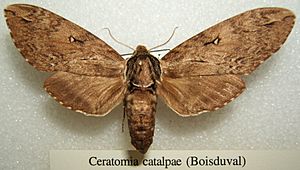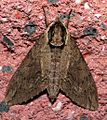Catalpa sphinx facts for kids
Quick facts for kids Catalpa sphinx |
|
|---|---|
 |
|
| Scientific classification | |
| Synonyms | |
|
The catalpa sphinx (scientific name: Ceratomia catalpae) is a type of hawk moth. These moths are also known as sphinx moths. A scientist named Jean Baptiste Boisduval first described this species in 1875.
Contents
Where Do Catalpa Sphinx Moths Live?
The catalpa sphinx moth lives in southeastern North America. You can find them where catalpa trees grow. Their range stretches from Maine in the east to Iowa in the west. They also live south to Florida, the Gulf States, and Texas.
Life Cycle of the Catalpa Sphinx
The catalpa sphinx moth goes through several stages in its life. From the time the eggs are laid until the insect becomes a pupa, about four weeks pass. If there are many generations (broods) in a year, the pupae can hatch into adults in just two weeks. Adult catalpa sphinx moths are a dull brown. They don't have the bright colors of their younger stages.
Egg Stage
Catalpa sphinx eggs are tiny, about 0.5 mm wide. They are usually milky-white, green, or yellowish and look a bit see-through. Female moths lay their eggs in large groups of 100 to 1000. They place them on the underside of catalpa leaves or on branches. The eggs hatch into larvae in about five to seven days.
Larva Stage (Caterpillar)
The larva of the catalpa sphinx is called a catalpa worm or catawba worm. When they first hatch, they are very pale. As they grow, they become darker. These yellow caterpillars usually have a dark, black stripe down their back. They also have black dots along their sides. Some caterpillars are paler, with less black or even a white stripe instead. They can grow to about 5 cm (2.0 in) long. They eat the leaves of northern catalpa and southern catalpa trees. Fishermen often use these caterpillars as bait.
Pupa Stage
Like many other Sphingidae moths, the catalpa sphinx caterpillar burrows into the ground. This happens after its fifth and final growth stage (instar). The caterpillar will leave the catalpa tree to find a good spot to bury itself. Once underground, it sheds its skin one last time. This reveals its pupal skin, which is soft and clear at first. It then hardens into a light brown color for protection.
Adult Stage
The adult catalpa sphinx moth is brown. It has a dark brown or black band around its middle body part, called the thorax. Each forewing has a small, dark mark in the middle, with a white dot. The moth's body is about 30 mm long. Its wings can spread from 65 to 95 mm wide.
=Images for kids
What Do Catalpa Sphinx Moths Eat?
Catalpa sphinx caterpillars eat the leaves of catalpa trees. Sometimes, there are so many caterpillars that they can eat almost all the leaves off a tree. This is called defoliation. People once thought this was very harmful to the trees. In fact, the first time airplanes were used to spray crops (called aerial crop dusting), it was to try and control these caterpillars.
However, new research suggests that catalpa trees are very tough. They can lose all their leaves multiple times in one summer and still survive. They even grow back healthy! Some scientists wonder if there might be a special relationship between the caterpillars and the trees.
The main food plants for the catalpa sphinx are:
- Catalpa bignonioides, also known as southern catalpa
- Catalpa speciosa, also known as northern catalpa
Images for kids








